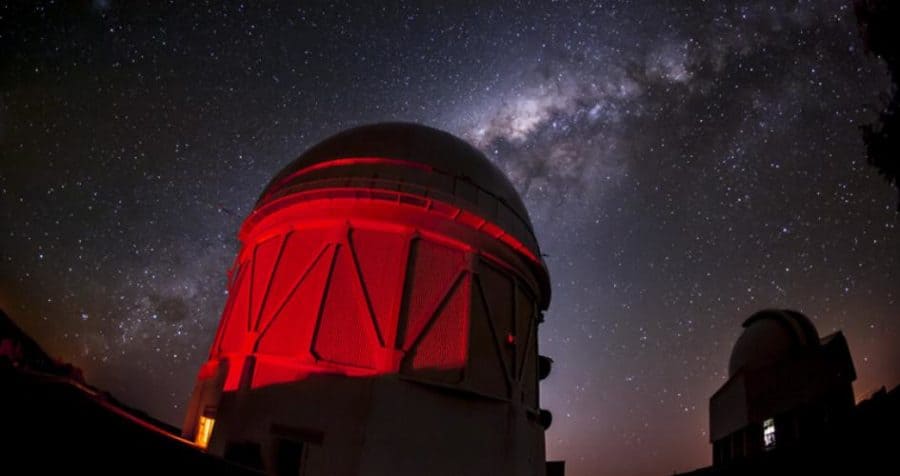Imagine planting a single seed and, with great precision, being able to predict the exact height of the tree that grows from it. Now imagine traveling to the future and snapping photographic proof that you were right.
If you think of the seed as the early universe, and the tree as the universe the way it looks now, you have an idea of what the international Dark Energy Survey collaboration has just done. Scientists unveiled their most accurate measurement of the present large-scale structure of the universe at a meeting Aug. 3 at the University of Chicago-affiliated Fermi National Accelerator Laboratory. UChicago, Argonne and Fermilab scientists are members of international Dark Energy Survey collaboration.
These measurements of the amount and “clumpiness” (or distribution) of dark matter in the present-day cosmos were made with a precision that, for the first time, rivals that of inferences from the early universe by the European Space Agency’s orbiting Planck observatory. The new Dark Energy Survey result (the tree, in the above metaphor) is close to “forecasts” made from the Planck measurements of the distant past (the seed), allowing scientists to understand more about the ways the universe has evolved over 14 billion years.

“This result is beyond exciting,” said Fermilab’s Scott Dodelson, a professor in the Department of Astronomy and Astrophysics at UChicago and one of the lead scientists on this result, which was announced at the American Physical Society Division of Particles and Fields meeting. “For the first time, we’re able to see the current structure of the universe with the same clarity that we can see its infancy, and we can follow the threads from one to the other, confirming many predictions along the way.”
Most notably, this result supports the theory that 26 percent of the universe is in the form of mysterious dark matter and that space is filled with an also-unseen dark energy, which makes up 70 percent and is causing the accelerating expansion of the universe.
Paradoxically, it is easier to measure the large-scale clumpiness of the universe in the distant past than it is to measure it today. In the first 400,000 years following the Big Bang, the universe was filled with a glowing gas, the light from which survives to this day. The Planck observatory’s map of this cosmic microwave background radiation gives us a snapshot of the universe at that very early time. Since then, the gravity of dark matter has pulled mass together and made the universe clumpier over time. But dark energy has been fighting back, pushing matter apart. Using the Planck map as a start, cosmologists can calculate precisely how this battle plays out over 14 billion years.
“These first major cosmology results are a tribute to the many people who have worked on the project since it began 14 years ago,” said Dark Energy Survey Director Josh Frieman, a scientist at Fermilab and a professor in the Department of Astronomy and Astrophysics at UChicago. “It was an exciting moment when we unveiled the results to ourselves just last month, after carrying out a ‘blind’ analysis to avoid being influenced by our prejudices.”
The Dark Energy Survey is a collaboration of more than 400 scientists from 26 institutions in seven countries. Its primary instrument is the 570-megapixel Dark Energy Camera, one of the most powerful in existence, which is able to capture digital images of light from galaxies eight billion light years from Earth. The camera was built and tested at Fermilab, the lead laboratory on the Dark Energy Survey, and is mounted on the National Science Foundation’s four-meter Blanco telescope, part of the Cerro Tololo Inter-American Observatory in Chile. The DES data are processed at the National Center for Supercomputing Applications at the University of Illinois at Urbana-Champaign.
Scientists are using the camera to map an eighth of the sky in unprecedented detail over five years. The fifth year of observation will begin this month. The new results draw only from data collected during the survey’s first year, which covers one-thirtieth of the sky.
Scientists used two methods to measure dark matter. First, they created maps of galaxy positions as tracers, and second, they precisely measured the shapes of 26 million galaxies to directly map the patterns of dark matter over billions of light years, using a technique called gravitational lensing.
To make these ultra-precise measurements, the team developed new ways to detect the tiny lensing distortions of galaxy images—an effect not even visible to the eye, enabling revolutionary advances in understanding these cosmic signals. In the process, they created the largest guide to spotting dark matter in the cosmos ever drawn. The new dark matter map is ten times the size of the one that the Dark Energy Survey released in 2015 and will eventually be three times larger than it is now.
“The Dark Energy Survey has already delivered some remarkable discoveries and measurements, and they have barely scratched the surface of their data,” said Fermilab Director Nigel Lockyer. “Today’s world-leading results point forward to the great strides DES will make toward understanding dark energy in the coming years.”


